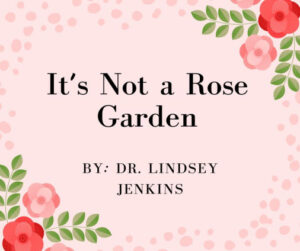 Hello! Dr. Jenkins here to talk about vulvar and vaginal hygiene and what is “normal”. TLDR version: It’s not a rose garden and should not be expected to smell like one!
Hello! Dr. Jenkins here to talk about vulvar and vaginal hygiene and what is “normal”. TLDR version: It’s not a rose garden and should not be expected to smell like one!
Long version: To start, I’d like to clarify 2 commonly misused terms- vulva and vagina. The vulva refers to the external female genitalia including the labia majora, labia minora, and clitoris. The vagina refers to internal female genitalia. The area where these 2 structures meet is called the vestibule- right at the opening to the vagina. Female anatomy is very complex and as women, we deserve to understand how our bodies are put together. For decades, women have been subjected to harmful advertising (I’m looking at you Vagisil and Summer’s Eve) which has led them to think the vulva and vagina are “dirty” and therefore require special cleaning to keep them “fresh” and smelling “pretty”. This has resulted in the use of harmful products which do nothing other than disrupting the normal bacterial balance and pH of the vulva and vagina. This often leads to the development of bacterial vaginosis (BV) and/or yeast infections. Additionally, many women may be shamed by romantic partners for normal vaginal discharge or odor due to societal expectations on what a female vulva and vagina should look and smell like. But I’m here to tell you the vulva and vagina are marvelous self-cleaning structures! Truly the only thing required to “clean” your vulva and vagina is plain, warm water! No joke, that is it. I do not recommend scented or antibacterial soaps, feminine washes, bubble baths or bath bombs, douches, or other products marketed to “clean” or “refresh” the vulva and vagina. These products will kill the good bacteria which maintain the normal pH balance of the vagina and allow odor and discharge-producing bacteria to overgrow. What follows is often a vicious cycle of continued cleansing to wash away the discharge and odor followed by further overgrowth of odor-causing bacteria and yeast. Normal vaginal discharge is typically white to slightly yellow in color with a mild, non-irritating odor. The amount of discharge produced often varies with the timing of your menstrual cycle and can be affected by medications such as hormonal birth control. Some women naturally make more discharge than others and that is ok! If the discharge you are noticing is thick/clumpy and white, green, has a foul, fishy odor, or is accompanied by significant itching or irritation you should see your gynecologist to be tested for BV and yeast. Lastly, the hair on the vulva serves a very important purpose which is to protect the delicate skin underneath it. When we remove this protective barrier sweat, bacteria and other contact irritants come into direct contact with that delicate skin and can lead to chronic itching, irritation, and discomfort. It is totally ok to prefer some degree of hair removal or trimming but if you notice persistent vulvar irritation, take a break from the shaving/waxing/trimming, and see your gynecologist for an exam! I will leave you with a great mainstream, evidence-based resource for all things vulva and vagina- a book so aptly named “The Vagina Bible” by Dr. Jen Gunter.
If you are experiencing any of the above-mentioned symptoms or if you simply have questions on what is “normal”, call our office and schedule an appointment with one of our vulvar/vaginal experts!
We are accepting new patients! To schedule an appointment with OBGYN Associates, call us at 515-288-3287.
DISCLAIMER: All information on this website is provided for informational purposes only and is not intended to be construed as medical advice. OBGYN Associates shall not be liable for any errors or inaccuracies contained herein, or any actions taken in reliance thereon.

Hello! Dr. Jenkins here to talk about vulvar and vaginal hygiene and what is “normal”. TLDR version: It’s not a rose garden and should not be expected to smell like one!
Long version: To start, I’d like to clarify 2 commonly misused terms- vulva and vagina. The vulva refers to the external female genitalia including the labia majora, labia minora, and clitoris. The vagina refers to internal female genitalia. The area where these 2 structures meet is called the vestibule- right at the opening to the vagina. Female anatomy is very complex and as women, we deserve to understand how our bodies are put together. For decades, women have been subjected to harmful advertising (I’m looking at you Vagisil and Summer’s Eve) which has led them to think the vulva and vagina are “dirty” and therefore require special cleaning to keep them “fresh” and smelling “pretty”. This has resulted in the use of harmful products which do nothing other than disrupting the normal bacterial balance and pH of the vulva and vagina. This often leads to the development of bacterial vaginosis (BV) and/or yeast infections. Additionally, many women may be shamed by romantic partners for normal vaginal discharge or odor due to societal expectations on what a female vulva and vagina should look and smell like. But I’m here to tell you the vulva and vagina are marvelous self-cleaning structures! Truly the only thing required to “clean” your vulva and vagina is plain, warm water! No joke, that is it. I do not recommend scented or antibacterial soaps, feminine washes, bubble baths or bath bombs, douches, or other products marketed to “clean” or “refresh” the vulva and vagina. These products will kill the good bacteria which maintain the normal pH balance of the vagina and allow odor and discharge-producing bacteria to overgrow. What follows is often a vicious cycle of continued cleansing to wash away the discharge and odor followed by further overgrowth of odor-causing bacteria and yeast. Normal vaginal discharge is typically white to slightly yellow in color with a mild, non-irritating odor. The amount of discharge produced often varies with the timing of your menstrual cycle and can be affected by medications such as hormonal birth control. Some women naturally make more discharge than others and that is ok! If the discharge you are noticing is thick/clumpy and white, green, has a foul, fishy odor, or is accompanied by significant itching or irritation you should see your gynecologist to be tested for BV and yeast. Lastly, the hair on the vulva serves a very important purpose which is to protect the delicate skin underneath it. When we remove this protective barrier sweat, bacteria and other contact irritants come into direct contact with that delicate skin and can lead to chronic itching, irritation, and discomfort. It is totally ok to prefer some degree of hair removal or trimming but if you notice persistent vulvar irritation, take a break from the shaving/waxing/trimming, and see your gynecologist for an exam! I will leave you with a great mainstream, evidence-based resource for all things vulva and vagina- a book so aptly named “The Vagina Bible” by Dr. Jen Gunter.
If you are experiencing any of the above-mentioned symptoms or if you simply have questions on what is “normal”, call our office and schedule an appointment with one of our vulvar/vaginal experts!
We are accepting new patients! To schedule an appointment with OBGYN Associates, call us at 515-288-3287.
DISCLAIMER: All information on this website is provided for informational purposes only and is not intended to be construed as medical advice. OBGYN Associates shall not be liable for any errors or inaccuracies contained herein, or any actions taken in reliance thereon.





Leave A Comment